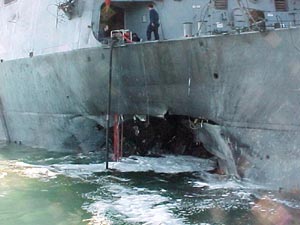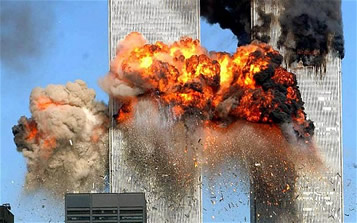

Major Attacks against America and
its citizens
1920-2010
1920
Sept. 16, New York City:
- TNT bomb planted in unattended horse-drawn wagon exploded on Wall Street opposite the House of Morgan, killing 35 people and injuring hundreds more. Bolshevist or anarchist terrorists believed responsible, but the crime was never solved.
1975
Jan. 24, New York City:
- Bomb set off in historic Fraunces Tavern killed 4 and injured more than 50 people. Puerto Rican nationalist group (FALN) claimed responsibility, and police tied 13 other bombings to the group.
1979
Nov. 4, Tehran, Iran:
- Iranian radical students seized the U.S. embassy, taking 66 hostages. Fourteen were later released. The remaining 52 were freed after 444 days on the day of President Reagan's inauguration.
1982–1991
Lebanon:
- Thirty US and other Western hostages kidnapped in Lebanon by Hezbollah. Some were killed, some died in captivity, and some were eventually released. Terry Anderson was held for 2,454 days.
1983
April 18, Beirut, Lebanon:
- U.S. embassy destroyed in suicide car-bomb attack; 63 dead, including 17 Americans. The Islamic Jihad claimed responsibility.
Oct. 23, Beirut, Lebanon:
- Shiite suicide bombers exploded truck near U.S. military barracks at Beirut airport, killing 241 Marines. Minutes later a second bomb killed 58 French paratroopers in their barracks in West Beirut.
Dec. 12, Kuwait City, Kuwait:
- Shiite truck bombers attacked the U.S. embassy and other targets, killing 5 and injuring 80.
1984
Sept. 20, East Beirut, Lebanon:
- A truck bomb exploded outside the U.S. embassy annex, killing 24, including 2 U.S. military.
Dec. 3, Beirut, Lebanon:
- Kuwait Airways Flight 221, from Kuwait to Pakistan, hijacked and diverted to Tehran. Two Americans killed.
1985
April 12, Madrid, Spain:
- Bombing at restaurant frequented by U.S. soldiers, killed 18 Spaniards and injured 82.
June 14, Beirut, Lebanon:
- TWA flight 847 en route from Athens to Rome hijacked to Beirut by Hezbollah terrorists and held for 17 days. A U.S. Navy diver was executed.
Oct. 7, Mediterranean Sea:
- Gunmen attack Italian cruise ship, Achille Lauro. One U.S. tourist killed. Hijacking linked to Libya.
Dec. 18, Rome, Italy, and Vienna, Austria:
- Airports in Rome and Vienna were bombed, killing 20 people, 5 of whom were Americans. Bombing linked to Libya.
1986
April 2, Athens, Greece:
- A bomb exploded aboard TWA flight 840 en route from Rome to Athens, killing 4 Americans and injuring 9.
April 5, West Berlin, Germany:
- Libyans bombed a disco frequented by U.S. servicemen, killing 2 and injuring hundreds.
1988
Dec. 21, Lockerbie, Scotland:
- N.Y.-bound Pan-Am Boeing 747 exploded in flight from a terrorist bomb and crashed into Scottish village, killing all 259 aboard and 11 on the ground. Passengers included 35 Syracuse University students and many U.S. military personnel. Libya formally admitted responsibility 15 years later (Aug. 2003) and offered $2.7 billion compensation to victims' families.
1992
December 29, Aden, Yemen:
- The first attack by Al Qaeda was carried out in Aden, Yemen. That evening, a bomb went off at the Gold Mohur hotel, where U.S. troops had been staying while en-route to Somalia, though the troops had already left when the bomb exploded. The bombers targeted a second hotel, the Aden Movenpick, where they believed American troops might also be staying. That bomb detonated prematurely in the hotel car park, around the same time as the other bomb explosion, killing two Australian tourists. Bin Laden later claimed that he was responsible for the attack.
1993
Feb. 26, New York City:
- Ramzi Yousef parked a rented van full of explosives in the parking garage beneath the World Trade Center. The bomb exploded killing 6 and injuring at least 1,040 others. In 1995, militant Islamist Sheik Omar Abdel Rahman and 9 others were convicted of conspiracy charges, and in 1998, Ramzi Yousef, believed to have been the mastermind, was convicted of the bombing. Al-Qaeda involvement is suspected. Yousef was the nephew of 9/11 planner Khalid Sheikh Mohammed and worked in cooperation with the blind sheikh Abdul Rahman who was living across the Hudson, in Jersey City, at the time of the attack. The FBI later turned up evidence that Osama bin Laden provided financial support.
1995
April 19, Oklahoma City:
- A car bomb exploded outside federal office building, collapsing wall and floors. 168 people were killed, including 19 children and 1 person who died in rescue effort. Over 220 buildings sustained damage.Timothy McVeigh and Terry Nichols later convicted in the antigovernment plot to avenge the Branch Davidian standoff in Waco, Tex., exactly two years earlier.
Nov. 13, Riyadh, Saudi Arabia:
- A car bomb exploded at U.S. military headquarters, killing five U.S. military servicemen
1996
June 25, Dhahran, Saudi Arabia:
- A truck bomb exploded outside Khobar Towers military complex, killing 19 American servicemen and injuring hundreds of others. Thirteen Saudis and a Lebanese, all alleged members of Islamic militant group Hezbollah, were indicted on charges relating to the attack in June 2001.
1998
Aug. 7, Nairobi, Kenya, and Dar es Salaam, Tanzania:
- A truck bombs exploded almost simultaneously near 2 U.S. embassies, killing 224 (213 in Kenya and 11 in Tanzania) and injuring about 4,500. Four men connected with al-Qaeda two of whom had received training at al-Qaeda camps inside Afghanistan, were convicted of the killings in May 2001 and later sentenced to life in prison. A federal grand jury had indicted 22 men in connection with the attacks, including Saudi dissident Osama bin Laden, who remained at large.
1999-2000
December:
- Al-Qaeda planned attacks against U.S. and Israeli tourists visiting Jordan for millennial celebrations. However, Jordanian authorities thwarted the plan and put 28 suspects on trial. Part of this plot included the bombing of LAX, but this plot was foiled when bomber Ahmed Ressam was caught at the US-Canadian border with explosives in the trunk of his car. Al-Qaeda also planned to attack the USS Sullivans on January 3, 2000, but the effort failed due to too much weight being put on the small boat meant to bomb the ship.
2000
Oct. 12, Aden, Yemen:
- U.S. Navy destroyer USS Cole heavily damaged when a small boat loaded with explosives blew up alongside it. Seventeen sailors killed. Linked to Osama bin Laden, or members of al-Qaeda terrorist network.

2001
Sept. 11, New York City, Arlington, Va., and Shanksville, Pa.:
- Hijackers crashed two commercial jets into twin towers of World Trade Center; two more hijacked jets were crashed into the Pentagon and a field in rural Pa. Total dead and missing numbered 2,9921: 2,749 in New York City, 184 at the Pentagon, 40 in Pa., and 19 hijackers. Islamic al-Qaeda terrorist group blamed.

Virtual presentation of the attacks
on the World Trade Center
2002
June 14, Karachi, Pakistan:
- A bomb exploded outside American consulate in Karachi, Pakistan, killing 12. Linked to al-Qaeda.
October 12, Bali, Indonesia:
- Bombs detonated in the tourist district of Kuta. The attack was the deadliest act of terrorism in the history of Indonesia, killing 202 people, (including 88 Australians, and 38 Indonesian citizens). A further 240 people were injured.
2003
May 12, Riyadh, Saudi Arabia:
- Suicide bombers killed 34, including eight Americans, at housing compounds for Westerners. Al-Qaeda suspected.
2009
June 1 Little Rock, Arkansas:
- Muslim convert Abdulhakim Mujahid Muhammad opened fire in a drive-by shooting on a United States military recruiting office, killing one US soldier and wounding another. At the time he stated that the act was "for the sake of Allah, the Lord of all the world, and also a retaliation on U.S. military." Law enforcement authorities concluded "there doesn't appear to be a wider conspiracy or, at this point in time, any indication that he's a part of a larger group or a conspiracy." However he later professed that he had conducted a "Jihadi attack" as part of Al Qaeda.
December 4, Afghanistan:
- An Al-Qaeda agent posing as a double agent killed 7 CIA officers. The Jordanian man, was thought to be an American asset penetrating Al-Qaeda. The explosion also killed 1 Jordanian intelligence officer, and seriously wounding six others.
December 25 Northwest Airlines Flight 253:
- Twenty three year old Umar Farouk Abdulmutallab, attempted to blow up a passenger jet en route from the Netherlands to Detroit by concealing plastic explosives in his underwear. However. he failed to detonate them properly, resulting in flames and popping noises. A Dutch passenger, Jasper Schuringa, tackled and restrained him and put out the fire with the aid of others. Abdulmutallab was then handcuffed while the pilot safely landed the plane. On December 28, Al-Qaeda in the Arabian Peninsula (AQAP) claimed responsibility for the attempted bombing. On January 6, 2010, a federal grand jury indicted Abdulmutallab on six criminal charges, including attempted use of a weapon of mass destruction and attempted murder.
- Shortly after his arrest, Abdulmutallab reportedly told officials he had traveled to Yemen for training by Al-Qaeda, although British counterterrorism officials dismissed the claims.
- President Barack Obama's top security official Janet Napolitano on December 27 stated "Right now we have no indication it's part of anything larger", warning it would be "inappropriate to speculate" that Al-Qaeda had sent Abdulmutallab on a suicide mission. On December 28, President Obama called it an "attempted terrorist attack" and promised to "to use every element of our national power to disrupt, to dismantle and defeat the violent extremists who threaten us, whether they are from Afghanistan or Pakistan, Yemen or Somalia...”
- That same day, Al Qaeda in the Arabian Peninsula claimed responsibility for the attack. The group released photos of Nigerian Umar Farouk Abdulmutallab smiling in a white shirt and white Islamic skullcap with the Al Qaeda in Arabian Peninsula banner in the background. On January 8, 2010, President Obama took responsibility for security lapses exposed by the attack, declaring in televised remarks "We are at war against Al-Qaeda", noting "our adversaries will seek new ways to evade them, as was shown by the Christmas attack"[ By February 2010, the suspect told federal investigators that cleric Anwar al-Awlaki gave him orders to carry out the attack. Al-Jazeera reported that Awlaki issued a statement that "Brother mujahed Umar Farouk – may God relieve him – is one of my students, yes... We had kept in contact, but I didn't issue a fatwa to Umar Farouk for this operation…”
2010
October 29:
- Two packages, each containing a bomb consisting of 300 to 400 grams (11–14 oz) of plastic explosives and a detonating mechanism, were found on separate cargo planes. The bombs were discovered as a result of intelligence received from Saudi Arabia's security chief. They were bound from Yemen to the United States, and were discovered at en route stop-overs, in England and in Dubai in the United Arab Emirates.
- One week later, al-Qaeda in the Arabian Peninsula (AQAP) took responsibility for the plot. U.S. and British authorities had believed that AQAP, and specifically Anwar al-Awlaki, were behind the bombing attempts. They also believed the bombs were most likely constructed by AQAP's main explosives expert, Ibrahim Hassan al-Asiri.
Music provided by freeplay.com
 Print
Print



